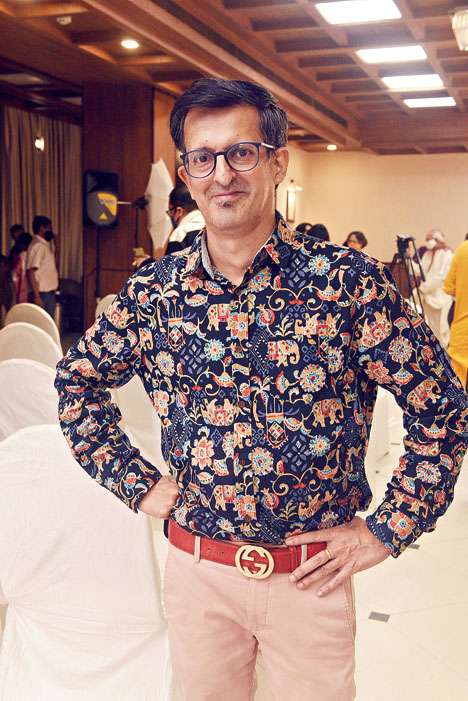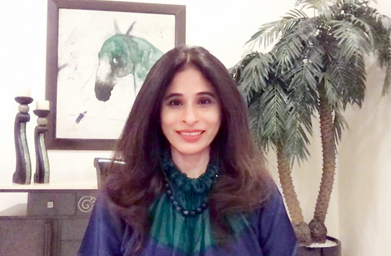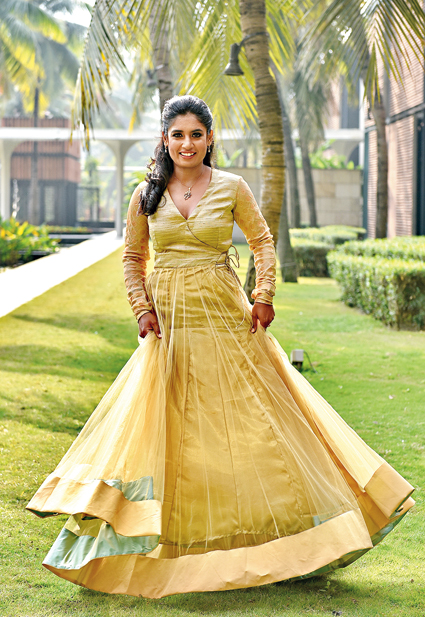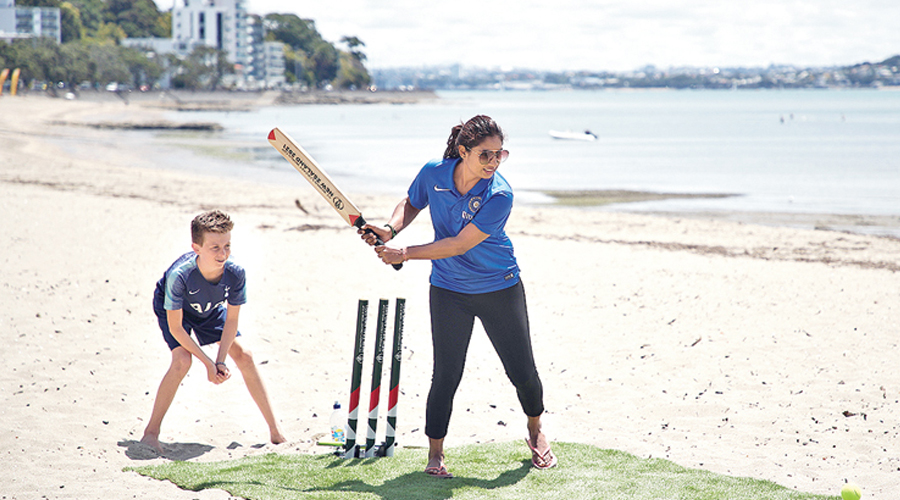A couple of years ago when we met the iconic Mithali Raj, we had asked her what had she taken away from her two-decade-long career. “That life goes on no matter what happens. If it is good, you enjoy and move on and if it is bad, you learn a lesson and move on, but you have to move on”. At a virtual Ladies Study Group session on Saturday, Mithali shared her mental toughness tips with two young girls who play cricket and idolise her. And, she spoke of the same switch-on, switch-off mantra. No wonder consistency has been her middle name.
‘Leading Team India’, moderated by cricket anchor, commentator and broadcaster Gautam Bhimani, saw the Indian women’s ODI captain, with many firsts and numerous records to her name, share her remarkable journey, which is as much defined by her steel as her belief in destiny. t2 took notes, once again.

Gautam Bhimani moderated the session Sourced by the correspondent
The 20 years...
I have always believed, irrespective of the format of cricket I play, it didn’t matter to me as long as I was getting runs. That is how I was brought up by my first coach, late Mr Sampath Kumar. Playing international cricket doesn’t only mean that you have the responsibility to score runs yourself, but you are the hope of millions and billions of people. When you are playing at that level, representing your national team and country, I think nothing less than 100 is what is expected of a player, in terms of the commitment. I have always worked to make sure that I am fit and I am not a liability to any team that I am representing, so that when I get on to the field, I am able to play whatever role is given to me. Even though I am not a fitness freak, I make sure that I am training every day and get (up to date) with the current standards of women’s cricket.
Cricket for a career...
It wasn’t my decision to become a cricketer. It was my dad’s decision to pursue this sport as a profession back then when there was nothing in women’s cricket. Until I played senior level in 1995, I didn’t know that we have legends like Shantha (Rangaswamy), Diana (Edulji), Sandhya Agarwal.... I did ask my dad to understand from which headspace he took the decision. There was absolutely no money. A lot of the girls pursued it only for the passion and love for the game. In terms of facility, there was none. We have played in parks and travelled in unreserved (compartments). Once in two years, you would get one international series and we had to run from pillar to post for sponsors.
We had a lot of issues at home. My grandparents didn’t want me to get into sports, leave alone cricket. For them it was the first time. To continue to support me in this career, my parents had to go through a lot of sacrifices. They have shielded me from a lot of negativity. I didn’t have to face sexism... but it was a very difficult decision. If I were in my parents’ shoes, I probably wouldn’t have taken that decision.
My father played for the Air Force and my brother till his school level. He wanted to see my brother do well in the sport, which he couldn’t, and I started doing well. For me, the motivation was to make my dad happy... even today, his validation is important.
It was a male-dominated sport and I was coached by a male coach and I have played with the boys and I still train with the boys. Now, I don’t think the round-table discussions are limited to men’s cricket. People do talk about women’s cricket and I am grateful that I have seen the evolution of women’s cricket from that era to today’s times and been a part of the journey.
It started (the transition), when we came under BCCI. The biggest change initially was that we could go to NCA (National Cricket Academy) where we train with the experts. Your awareness about your own game improves drastically and that reflects in your performance. Then we started having regular international series... a good three-four series in a year. Then the contracted players... that is the biggest change... where the board is taking care of the girls. I know of girls who come from the interiors of the country where the family depends on them for the finances. Being a contracted player really helps because you can still play cricket and look after your family. I think that is why a lot of girls are continuing after certain years. In the last three-four years, the way women’s cricket has burst into our country with the sort of branding it has on its own, I think now the parents are lenient and they don’t push them to settle down or change their profession to earn money. It looks lucrative now.
Hundred on debut at Milton Keynes, against Ireland, at 16...
The only thing I remember was the sort of pressure that I had on my shoulders. I remember the manager was also, like me, from Hyderabad. She told me (Mohammad) Azharuddin (who hails from Hyderabad) had scored three 100s in a row (in his first three Tests) and I should also score. When I scored the 100, I was satisfied that people who had expectations were happy. I was quite young to understand the entire platform that was given to me because back then nobody knew that the Indian team was touring England or this young girl made 100 on debut. If I would have done it in the current times, the impact would have been far better... then we didn’t have social media or the BCCI. It was good to see my dad happy and the people who encouraged me in the first few years.
Temper tricks...
I do understand the fact that when you are playing on the ground, there are so many things that run in your mind that you just want to focus on your next move and also not get the confidence of the players and the entire team down. So, I restrict myself from an outburst. In the team meetings, I rip them apart. I remember the Australia game in the 2017 World Cup where we lost in the league game, after which I had a bit of a talk with the girls. But it is not something I often do because I do have a lot of patience.... During the one-day World Cup that happened in 2013 in India, it was the first time under BCCI that we were hosting a big event and I remember Star Sports following the game against West Indies. Niranjana (Nagarajan) got hit two sixers back to back by (Deandra) Dottin. I had never seen such shots in women’s cricket before. I was on the ground and I had this expression on my face. She (Niranjana) said ‘I am playing on your side and you are smiling!’ This was captured on television. At the end of the day when I spoke to my dad, he asked me why I was smiling. He took it to a different tangent. It was a spur-of-the-moment reaction and I enjoyed that shot and she (Niranjana) knew that I hadn’t meant in a negative way. The girls know that there are times when I laugh on the field, even though the situation doesn’t demand it, but it is also one way of saying that things are still under control.
The double 100 in Test cricket (against England, 2002)...
We were coming from a very bad One Day series. The first Test was washed out. We were watching another Test where England was playing another team and one of the players scored a double 100. I shared how it would feel to score a double 100 and how many hours you would have focused, the temperament. And, how the boys jump in the air... I wanted to feel it once.
We were playing the Test with four batters. I didn’t expect to score a double hundred. For me, the first thing was to score a 50. When I scored a 100, I felt nice, but the job was still not done. When Jhulan (Goswami) joined me, I was almost tired. Imagine playing with a 1.5kg bat for 10 hours?! When I was on 205, the manager sent a word through the 12th man that I needed five runs to break the record. That’s how I scored. I don’t even have a recording of the innings.
I came back in AP Express from Delhi to Hyderabad. I was telling my friend there are so many people, maybe a minister was arriving. Later I realised they were there for me! That was the first time my mother had come to receive me. I was not used to so many people receiving me. My dad would drop me and pick me up. And, he was lost in the crowd! People had started to know women’s cricket.
Women’s cricket next-gen...
Yes, there is a lot of generation gap (in the team). I am into the fourth generation from when I started playing. A lot of the girls were not born when I made my debut. I walk in and they will go quiet (laughs).
Shafali (Verma) and her brother look like twins and I told her she can get him to women’s cricket and we will have another batter. I told her in a joking way. She said: ‘Jab mein hoon toh mera bhai ka kya zaroorat hai?’ When you speak to them, there is so much confidence you can take away.

Diya Jaiswal, president, Ladies Study Group Sourced by the correspondent
Mithali Raj is referred to as a living legend and the session demonstrated how perfect this title is for her. What made it more special for me was the fact that I was able to defy the barriers created by the current corona crisis, and invite two young women cricketers who are playing cricket at the state level, to join me in person for this session. These two budding cricketers travelled a long distance from the interiors to avail the opportunity to ask their role model and icon their own questions, and share screen space with her. At Ladies Study Group we have always stood for sport and emphasised the importance of the women in sport and to be able to successfully align with this organisational ethos despite the unprecedented times, and to experience the absolute joy and euphoria that the interaction brought to these two young girls first-hand, is what makes this session so significant — Diya Jaiswal, president, Ladies Study Group

Did you know?
Mithali also feels the jitters and she reads to keep them at bay. The Wormsley Test against England “tested” her as a “captain and player”. “I had eight debutantes in the team and we were playing that Test after a gap of eight years. There were only three girls who had played the 2006 Test... Jhulan, me and Karuna (Jain). To explain to them how a Test match is played and then it can change in an hour with the fall of three-four wickets.... Playing England in England was tough. They were Ashes winners back then. I had a lot of doubts. I wanted the team to give them a good fight. When we had to score 181 to win and one had dislocated her shoulder, I knew it was important for the top order to score as many runs possible. Smriti (Mandhana) and Thirush Kamini opened the innings. I was in the dressing room with Niranjana. Both of us have a common love for books. I was padded up and supposed to go in at number four. I heard a shout and asked Niranjana if anyone got out! I was reading a book because I didn’t want to watch the match. I didn’t even watch one ball. I read because I am nervous and I don’t want my teammates to know about it. I want to go in with an open mind,” she recounted. India won by six wickets and Mithali was 50 not out.
Mithali’s relax mantra
Reading, sketching and spending time with kids and animals because “they don’t judge you”.
